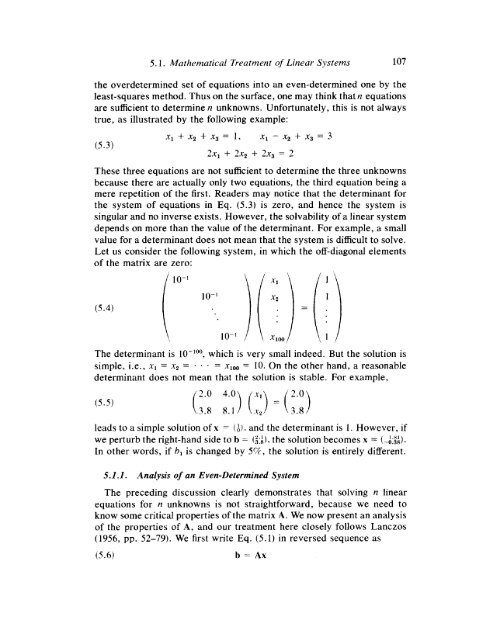principles and applications of microearthquake networks
principles and applications of microearthquake networks
principles and applications of microearthquake networks
Create successful ePaper yourself
Turn your PDF publications into a flip-book with our unique Google optimized e-Paper software.
5.1. Mathematical Treatment <strong>of</strong> Linear Systems 107<br />
the overdetermined set <strong>of</strong> equations into an even-determined one by the<br />
least-squares method. Thus on the surface, one may think that n equations<br />
are sufficient to determine n unknowns. Unfortunately, this is not always<br />
true, as illustrated by the following example:<br />
(5.3)<br />
x1 + x p + x3 = I, XI - x, + x3 = 3<br />
2x, + 2x, + 2x3 = 2<br />
These three equations are not sufficient to determine the three unknowns<br />
because there are actually only two equations, the third equation being a<br />
mere repetition <strong>of</strong> the first. Readers may notice that the determinant for<br />
the system <strong>of</strong> equations in Eq. (5.3) is zero, <strong>and</strong> hence the system is<br />
singular <strong>and</strong> no inverse exists. However, the solvability <strong>of</strong> a linear system<br />
depends on more than the value <strong>of</strong> the determinant. For example, a small<br />
value for a determinant does not mean that the system is difficult to solve.<br />
Let us consider the following system, in which the <strong>of</strong>f-diagonal elements<br />
<strong>of</strong> the matrix are zero:<br />
The determinant is 10-loo, which is very small indeed. But the solution is<br />
simple, i.e., xi = xz = . - .<br />
-<br />
xloo = 10. On the other h<strong>and</strong>, a reasonable<br />
determinant does not mean that the solution is stable. For example,<br />
(5.5)<br />
leads to a simple solution <strong>of</strong> x = (A). <strong>and</strong> the determinant is 1. However, if<br />
we perturb the right-h<strong>and</strong> side to b = ($:A), the solution becomes x = (-4:;).<br />
In other words, if h, is changed by 555, the solution is entirely different.<br />
5.1.1.<br />
Analysis <strong>of</strong> an Even-Determined System<br />
The preceding discussion clearly demonstrates that solving n linear<br />
equations for n unknowns is not straightforward, because we need to<br />
know some critical properties <strong>of</strong> the matrix A. We now present an analysis<br />
<strong>of</strong> the properties <strong>of</strong> A, <strong>and</strong> our treatment here closely follows Lanczos<br />
(1956, pp. 52-79). We first write Eq. (5.1) in reversed sequence as<br />
(5.6) b = Ax






